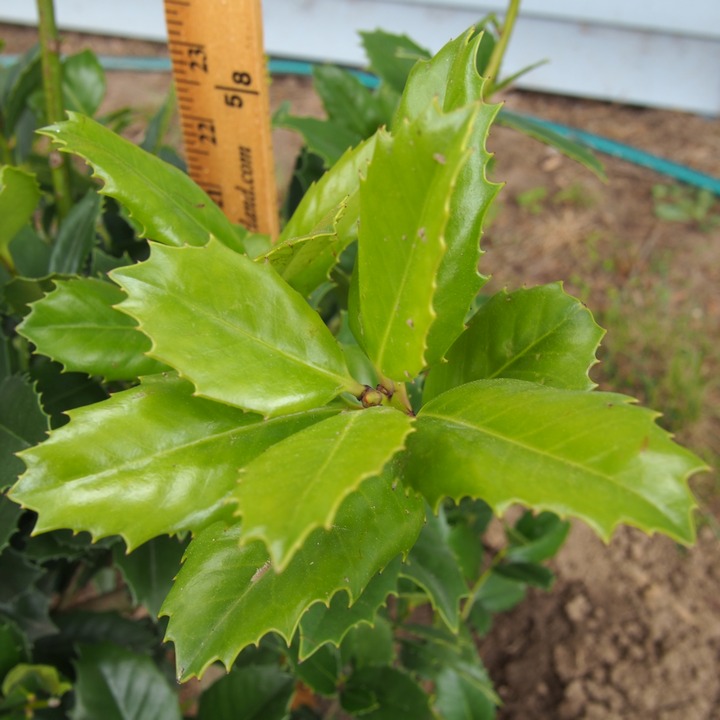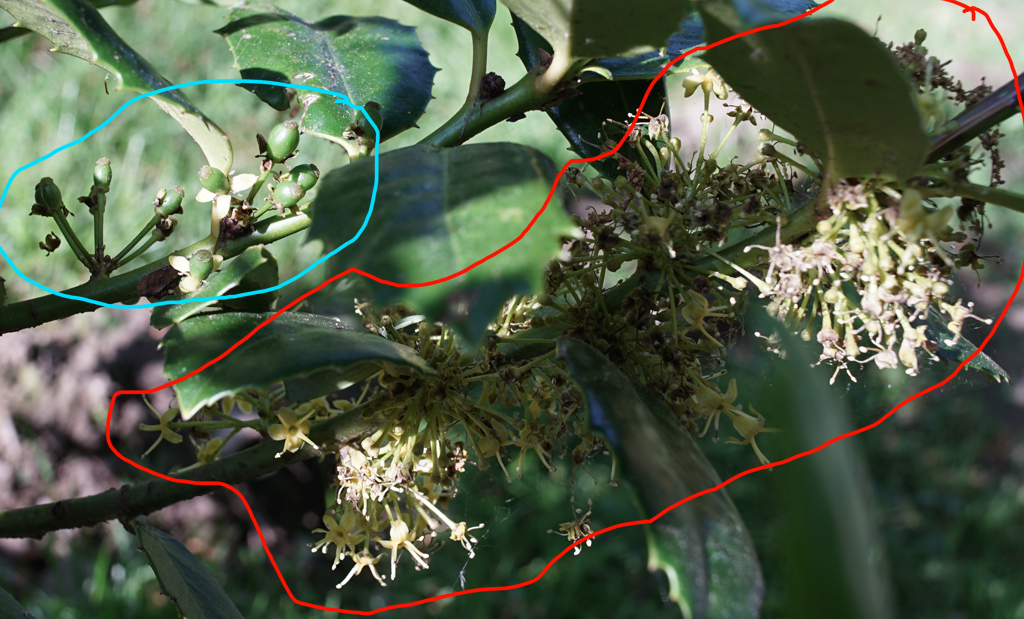




Source: Wilson Bros. Gardens (GA)
Size shipped: #3 pot (measured 2.5')
Planted: In ground, May 2020
First flowering: At the nursery
(This plant stayed behind when I moved in 2021; therefore, the following text will receive no further updates.)
'Emily Bruner', being a hybrid between Ilex cornuta 'Burfordii' and Ilex latifolia, is not actually the Ilex latifolia descendant I really wanted; that would be 'Mary Nell' [Ilex (cornuta x pernyi) x latifolia], for its amazing foliage. However, 'Emily Bruner' apparently grows faster and is cold hardier, an important consideration for someone living in Sunset zone 37 (considering that Sunset doesn't recommend either of these two hollies for anything north of Zone 32, which basically means anywhere above the fall line) and USDA zone 6 (unless you ask the Arbor Day Foundation, who used data as of 2015 that have basically all of New Jersey in zone 7 instead).
While Wilson Bros. did manage to get Federal Express to get the tree from Georgia to New Jersey in two days' transit time (after a few days of processing), and it looked nice and healthy when it arrived, I was not at all pleased with the roots. The outside of the root ball was covered in them, and it took a good deal of effort to loosen things up and stop some of the roots from circling. I made no attempt to bare-root this holly before planting -- the root ball stayed mostly intact except for some substrate loosened from the very edges -- so I expected to be watering frequently over the ensuing weeks, though that actually ended up not being necessary (I'm guessing due to clay soil, like with the Jane magnolia in 2019?).
However, I also ended up planting the holly just about at grade, instead of an inch or two above grade like many of my other plants. Because the root ball remained intact, the soil dug out of the hole was more than what would go back in it once the holly was in place, so I did something I have never really had enough soil to be able to do before: build a berm to prevent runoff. This also meant that I did not mulch, because I would not be able to prevent the mulch from running down the slope towards the trunk and encouraging rot if I did, unlike with other plantings where the surface soil was more or less flat (or convex).
Another first for this planting was finally making use of my cheap soil test kit. The pH reading came in around 5.5-6.0, perfect for a holly, and the phosphorus and potassium tests read as adequate. But the nitrogen showed up as depleted -- and I'm not sure whether this is because I took the soil sample from half the depth I was supposed to (due to missing that part of the instructions until after I had started) or because it really was that bad; I chalked it up to the grass-cutting crew not leaving the grass clippings on the ground for the past two years. Unfortunately, the N/P/K tests take 10 minutes to develop; by the time I had my N result, I had already added back all the soil. So I ended up adding feather meal on top of the soil and trying to water it in... and soon thereafter realizing that maybe I should have cultivated it into the soil a little before adding water.
I have no idea why, but Emily actually bloomed lightly on some of its lower branches in September and October 2020, and looked to continue the pattern in November(!). This seems incredibly useless considering I don't know of any male hollies that would bloom at the same time for successful pollination. It kind of makes me worry that I did something wrong, but I can't think of what.
Despite Emily being of borderline hardiness for our area, she did pull through her first New Jersey winter with very little apparent damage. The contrast with the adjacent Ocala anise, which had so many of its leaves burned orange, was striking. To be fair, it was a winter in which temperatures stayed in double digits the whole time, so not nearly as bad as it could have been. But there was still snow. Oh, so much snow...
In May 2021 I took a closer look at the blooms and noticed something that should have been impossible: male flowers along with the female ones! Investigating further, I realized that all the male flowers were on branches emanating from one trunk and all the female flowers on branches off the other trunk. In other words, I was actually shipped two hollies in the same pot. Unfortunately, Wilson Bros. didn't know what cultivar the male was, as they said they must have received the original liner that way from the wholesaler -- they do not bundle hollies thus. Since the foliage was so consistent that I never suspected anything until I saw those staminate flowers, I'm guessing that the male is 'James Swan', the fabled ideal pollinator for Emily Bruner that I never see anyone actually selling anywhere. Shout-out to the customer service folks at Wilson Bros., as they handled the mixup very well, and the only thing that would have left me more satisfied is if they'd been able to confirm the identity of the male clone.